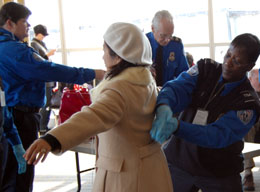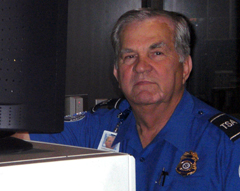TSA Weekly Jan. 26-30, 2009

 Homeland Security Secretary Janet Napolitano talks with employees Jan. 26 at TSA headquarters. Read the story. Photo by Michael Simons |
News 
More News |
News
New Homeland Security Secretary Talks with TSA Employees
By Michael Simons, Office of Strategic Communications/Public Affairs

Homeland Security Secretary Janet Napolitano (center)
talks with Mardi Thompson, deputy Chief Counsel for
Regulations & Security Standards, Office of
Chief Counsel. Photo by Michael Simons
Janet Napolitano visited TSA headquarters Jan. 26, just five days after being sworn in as the new Secretary for Homeland Security. She immediately thanked everyone at the agency for "the enormous amount of work that's been done to date to stand up TSA, particularly in the aviation area," then soon turned it over to the audience for an open dialogue.
"You've got a very important and delicate role to play," she said, "because if people are afraid, they won't travel. ... And we saw that in the aftermath of 9/11. So part of our job is to make sure that people have a comfort factor with us and they know there is safety in traveling."
She also said that "greater in-depth" focus should be given to surface transportation, specifically mentioning rail and mass transit.
Before she was introduced by Acting Administrator Gale Rossides at the town hall event, Napolitano was shown a slide presentation that featured security technology currently deployed across the nation's airports. She was also given a summary of Security Evolution's pillars – people, process and technology, and partnerships – by Assistant Administrator for Security Operations Lee Kair. He also outlined the intelligence-based elements of Evolution.
Napolitano introduced a few members of her senior staff as well as TSA's incoming chief of staff, Art Macias. She, in turn, was introduced to a couple of TSA employees who presented additional information. Bob Burns, program analyst, Strategic Communications/Public Affairs, talked about TSA's blog, and Lisa Thorn, supervisory TSO, Ronald Reagan Washington National Airport, demonstrated liquids scanner technology.
During her dialogue with employees, Napolitano reiterated the vision of a unified Department that she outlined during her confirmation hearing last week. She also emphasized information sharing and communication.
"How we communicate with people and how we make people understand that they are also part of their own security" is important, she said. "We are the government, but we are not the exclusive answer to this issue. Everybody has a role."
Before becoming Homeland Security Secretary, Napolitano was governor of Arizona where she implemented one of the first state homeland security strategies in the nation, opened the first state counter-terrorism center, and was a pioneer in coordinating federal, state, local and bi-national homeland security efforts. Earlier in her career, Napolitano, as a U.S. attorney, helped lead the domestic terrorism investigation into the Oklahoma City Bombing.
After the town hall event, Napolitano fielded questions from national media reporters.
A Message from Gale:
Open Communication With You is Very Important to Me
TSA is all about the people. It is the combined insight, intuition, and experience of our people that drive the technology and processes that create the best transportation security in the world. With enhanced communication we can improve our collective ability to achieve our mission. That's why open and frequent communication with the workforce is one of my highest priorities as acting administrator.
Every day there are issues of importance to you and critical information that we need to share with you. It is my commitment that TSA's leadership team will communicate with you, through various channels, on a frequent basis. Whether through broadcast e-mails, TSA Weekly, short points during shift briefings, teleconferences with employee networks, Web casts, or "A Message from Gale," we will keep you informed. I want to make sure that you get the timely information you need to do your jobs well and derive a sense of satisfaction to accompany your unwavering commitment.
Equally important as the information I need to get to you is the input and feedback from you that informs the decisions we make. I want to hear from you on the innovative and creative ideas that enable us to achieve continuous improvement. And I commit to providing timely responses to the ideas and concerns you raise through the many communication mechanisms we are strengthening, including the NAC, NAC network, ICMS network, communication champions, Peer Review facilitators, the IdeaFactory, Security Evolution networks, town hall meetings and Web casts. As you can see, there are many avenues to receive information, share best practices and have a voice in the growth of this great agency.
So, become involved, engaged and connected because we will make TSA – and DHS – better by communicating effectively and working together collaboratively. As one step in this process, I am launching "A Message from Gale" that you will see often. Look for it here and on the TSA iShare Homepage.


Lee Kair on Security Evolution
By Michael Simons, Office of Strategic Communications/Public Affairs
Lee Kair, assistant administrator for Security Operations, sat down to talk about Security Evolution, its impact so far and its use for continued culture change going forward.
What is the tipping point that will ensure Evolution's culture-change success and what is OSO doing to ensure we reach that point?
As you know, ENGAGE! and COACH! are not one-time training events – it is a culture change. And the longer-term program is to integrate the concepts of ENGAGE! and COACH! into everything that we do.
We are making sure the officers are equipped to use all of their skills and their networks to mitigate the threats, the main one being IEDs. Developing the officers' skills will ensure success.
After the training, which is being used to build the support structure for the frontline officers, the tipping point is when the officers are able to effectively use their instincts and critical thinking skills to find the threat – to find the IED.
As an example, instead of a traditional SOP, the NAC [National Advisory Council] recommended adopting a Threat Mitigation Guide, to include the elements of ENGAGE! The Threat Mitigation Guide gives context for why we do something. It includes the intelligence behind why we do something, not just a set of dos and don'ts. With this information, officers have what they need to engage their critical thinking.
The crux is that TSA must be a flexible, thinking organization.
How do we know when the officers are effectively equipped?
The first part of it is to ensure that all officers go through the training. We are ahead of schedule with almost 70 percent of all airports completed.
Next is how the officers implement what they learn in training. For instance – discretion. This doesn't mean that you can do whatever you feel like doing in a particular instance. Instead, this means that an officer has the SOP and guidance on how to do something. But, if the officer is not able to clear something, you have the discretion to use your network around you to go above the SOP to mitigate the risk or resolve the alarm.
If you go back to people who encountered known terrorists in the past – for example, Mohammad Atta and Richard Reid – the people who encountered those terrorists knew that something was wrong but didn't have a way to stop them.
So part of being an equipped workforce – an engaged workforce – means that when something does not look right, you must dig deeper into the situation. Under this circumstance it is appropriate to not clear someone into the sterile area just because the SOP was met.
How are elements of Evolution training – such as ENGAGE! and COACH! – being tied to other training requirements?
The Threat Mitigation Guide is a quick example – it's in the see-feel-think-do format of ENGAGE! training. Evolution principles must be baked into the culture. So another area we are already looking at is basic security officer training and deciding at what point in an officer's career we start training some of these principles. We are also looking at the follow-on training for officers and how often that should occur.
We are also looking at the best ways to tie some of these principles to PASS.
How will FSDs, area directors and senior leadership support both frontline leaders and the empowered workforce as COACH! principles are put into practice?
We have already had buy-in from the FSDs for some time. The FSDs will need to lead by example. Leading by example means practicing COACH! principles when an officer uses his or her discretion that leads to a wrong decision. The FSDs will support the workforce even in such cases, with the understanding that officers must make decisions within the framework taught in ENGAGE!.
To help with this, we are creating scenarios as teaching tools. This gives officers a chance to discuss what the thought processes will be in difficult situations – and what it means to trust your gut and articulate what you feel that led you to make the decision you did.
How do we define some of Security Evolution's terms – command presence, empowered workforce, trust your gut – to someone who hasn't had the benefit of ENGAGE! and COACH! training?
A lot of these terms are internal terms for use at TSA. Officers can explain it to others – family members for instance – in terms of what their jobs are, now. In 2002, they were screeners. But they are now officers.
The job of the officers is to use everything around them – especially their brains – to mitigate the threat. Instead of going after the prohibited item, we need to go after the intent.
Other thoughts?
Evolution is not a training program. This has been something that has been underway since 2005. This is continuing the trend of professionalizing the workforce and giving the officers all of the tools they need to mitigate the threat.
Evolution: In the FSD's Own Words
ENGAGE! and COACH! training continue our risk mitigation efforts by emphasizing finding the people who seek to harm commercial aviation while sustaining finding prohibited items.– FSD William F. "Bill" Allen, Denver International Airport
Engage the Evolution team with your questions and suggestions at ENGAGEevolution@dhs.gov.
More News
Screening a Success at National Capital Region Airports After Inauguration

TSO Sylita Johnson (right) and her colleagues
at Ronald Reagan Washington National Airport
met the high-volume challenge of screening
passengers here for the Inauguration. Photo by
Paul DiMaggio
TSOs at the National Capital Region's three airports will remember the heavy travel days that followed the inauguration of President Obama. As spectators left Washington, D.C., TSA met the unprecedented demand, screening 111,388 passengers on the day after the inauguration at Ronald Reagan Washington National Airport, Washington-Dulles International Airport and Baltimore-Washington Thurgood Marshall International Airport.
That high-volume challenge was met with extra staffing and extended hours as TSOs worked tirelessly to assist passengers through security screening and keep checkpoint lines moving. It helped, too, that travelers were in good spirits despite the crowds, appreciative of the opportunity to have witnessed the inauguration. – Lauren Gaches, Office of Strategic Comunications/Public Affairs






